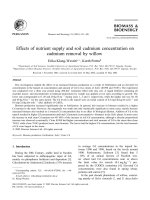4 19 effects of technology (space and technology)
Bạn đang xem bản rút gọn của tài liệu. Xem và tải ngay bản đầy đủ của tài liệu tại đây (3.44 MB, 10 trang )
Space and Technology
by Lorrie Oestreicher
Genre
Nonfiction
Comprehension Skill
Main Idea and Details •
•
•
•
Text Features
Captions
Labels
Call Outs
Glossary
Science Content
Technology
Scott Foresman Science 4.19
ISBN 0-328-13913-0
ì<(sk$m)=bdjbdc< +^-Ä-U-Ä-U
Vocabulary
What did you learn?
communication
1. What are some good and bad results of new
technology? by Lorrie Oestreicher
optical fibers
technology
telecommunications
vehicle
Photographs: Every effort has been made to secure permission and provide appropriate credit for
photographic material. The publisher deeply regrets any omission and pledges to correct errors called to its
attention in subsequent editions. Unless otherwise acknowledged, all photographs are the property of Scott
Foresman, a division of Pearson Education. Photo locators denoted as follows: Top (T), Center (C), Bottom
(B), Left (L), Right (R), Background (Bkgd).
Opener: (TR) ©Royalty-Free/Corbis, (Bkgd) ©Yang Liu/Corbis; Title Page: ©Courtesy of the Museum of
the Moving Image, London/DK Images; 2 ©Tibor Bognar/Corbis; 4 Getty Images; 5 Getty Images; 6
©Stevie Grand/Photo Researchers, Inc.; 7 ©Simon Jauncey/Getty Images; 8 (CL) ©James King-Holmes/
Photo Researchers, Inc., (Bkgd) ©Matt Meadows/Peter Arnold, Inc.; 10 (BC) ©DK Images, (R) ©Dave
King/DK Images; 11 (BL) ©Courtesy of the Museum of the Moving Image, London/DK Images, (CR)
Tina Chambers/Courtesy of the National Maritime Museum, London/©DK Images, (BR) Getty Images;
12 (CL, BR, CR, CC) ©Bettmann/Corbis, (BL) ©Archive Holdings Inc./Getty Images, (BC) George H.
Huey Photography, Inc.; 13 (BL) Dave King/Courtesy of the Science Museum, London/©DK Images, (CL)
©Museum of Flight/Corbis, (BC) ©Reuters/Corbis, (CR) Getty Images, (BR) ©Claro Cortes IV/Reuters/
Corbis; 14 ©Fukuhara, Inc./Corbis, Steve Gorton and Gary Ombler/©DK Images; 15 ©Tibor Bognar/
Corbis.
ISBN: 0-328-13913-0
Copyright © Pearson Education, Inc.
All Rights Reserved. Printed in the United States of America. This publication is
protected by Copyright and permission should be obtained from the publisher prior
to any prohibited reproduction, storage in a retrieval system, or transmission in any
form by any means, electronic, mechanical, photocopying, recording, or likewise. For
information regarding permissions, write to: Permissions Department, Scott Foresman,
1900 East Lake Avenue, Glenview, Illinois 60025.
3 4 5 6 7 8 9 10 V010 13 12 11 10 09 08 07 06 05
Effects of Technology
2. What are three things necessary for communication to
be successful?
3. How do transportation systems use computer technology?
4.
Technology has led to many
advancements in medicine. On your own paper, explain
how doctors use technology to give better care to their
patients. Use details from the book to support your
answer.
5.
Main Idea and Details What are some details
that support the main idea that technology has changed
the way we live?
How does technology
affect our lives?
New Challenges
We use technology all the time in everyday life. Technology
is the knowledge, processes, and products that we use to solve
problems and make our work easier. Technology makes our
lives more comfortable and healthy. It helps us get the things
we need.
Technology affects all living things. Sometimes technology’s
effects are unplanned. These effects can be harmful to living
things. Motor vehicle emissions, industrial wastes, and
insecticides are some of these unplanned, harmful effects. The
United States and other countries must deal with air, soil, water,
and noise pollution.
2
Technology has changed the way we do our jobs. It has
helped make work easier. Machines can produce more and
do work faster than people can. Unfortunately, this can lead
to people losing their jobs. Although technology can cause
problems, at the same time it can also help to solve them. Some
machines can do work that is too dangerous for people to do.
New technology can also bring new jobs. Many of these jobs are
in the electronics industry.
Technology may lead to more
cities that look like this one.
3
Technology and Materials
This in-line skater is using
many products of technology. The
materials in the equipment are not
all found in nature. Many were
made through technology. The
in-line skates and protective gear
are made from plastic, metal,
rubber, and nylon. Some of these
materials come mostly from natural
resources. Others come from
materials that have been made
from natural resources.
Iron ore is a natural resource. It
is used to make steel. You can find
steel in the wheel bearings, screws,
and axles of in-line skates. The
plastic materials are made from
chemicals. All of the plastic parts
are shaped into the different pieces
of equipment. Even clothing can be
made from chemicals or recycled
plastic materials.
4
Technology Keeps
Us Healthy
Technology helps produce new
equipment. It also helps us stay
safe and healthy. The gear worn
by the in-line skater can absorb
some of the impact of a fall.
The helmet can help protect his
head from an injury. The plastic
cushions in the knee and elbow
pads and in the wrist guards can
help protect his arms and legs.
Helmets are light, but
they have a hard outer
shell. This helps protect
the head from injuries.
Controlling Waste
Many wrist guards have
a tough nylon spine. This
supports and protects the
wrist and palm.
Polyurethane comes from
chemical technology. The
wheels of in-line skates
are often made of this
material.
Knee and elbow pads
are made of a kind
of foam covered by a
layer of hard plastic.
When products are made,
waste and pollution are also
made. Some companies are
trying to make products from
materials that can break down
and become part of nature
again. Not all materials break
down easily. Products that
are made through technology
often will not break down
easily. Products such as plastic,
glass, and aluminum should
be recycled. Then they can be
reused to make new products.
5
Technology and Medicine
Technology and Food
Medical technology has changed the tools and instruments
that doctors use. These changes improve the care people
receive. Doctors may now use lasers in operations instead of
using sharp knives. Lasers can open up clogged arteries. They
can even fix broken blood vessels.
Doctors also use optical fibers. These are thin tubes that
let light pass through them. Cameras with optical fibers help
doctors see inside the body. This helps doctors decide the best
way to treat a problem.
Keyhole surgery has reduced the pain and recovery time of
many surgeries. With this type of surgery, doctors make only a
cut about the size of a keyhole.
To be healthy, you must make good food choices. We get
our food from nature. To grow bigger and better crops, farmers
use tractors, chemical fertilizers, and pesticides. By using these
things, farmers can produce more. The crops they harvest
provide the foods we need to be healthy. But the technology
causes a problem if the pesticides and fertilizers harm the
environment.
Scanned image
of the brain
6
7
X rays and More
Machines also help doctors know more about our bodies. The
technology of the X-ray machine allows doctors to see inside
our bodies. A broken bone is easier to fix once it is seen in an
X ray. The X ray shows the doctor exactly where the break is
and how the bone is broken.
Wilhelm Roentgen discovered X rays in 1895. At first he
did not know what he had discovered. In science, the letter X
represents the unknown. Roentgen called what he found X rays.
This was the first time doctors could see inside the body without
even touching it.
Dentists use X rays to help them find where a cavity may
form in our teeth. X rays are also used to find tumors or help
treat cancer. But too much contact with X rays can cause burns.
It can even cause cancer.
Nuclear magnetic resonance, or NMR, is a technology that
helps doctors find the chemical makeup of matter. Magnetic
resonance imaging, or MRI, allows doctors to see things in our
bodies that X rays don’t show. This technology helps doctors
give their patients better treatment.
How X Rays Work
X rays pass through skin and
other organs. Bones, metal,
and other objects block the
rays and cast clear shadows
on film. We call the shadow
picture an X ray.
8
9
How has technology
changed communication
and transportation?
Communication
You are communicating any time you call someone,
send a letter, or write an email. Communication is
the process of sending any kind of message from one
place to another. Communication helps you let others
know what you need or what you are doing. Speaking
and writing are two ways you can communicate.
Three things must happen in communication. You
must send a message. The message must be received.
Then it must be understood. Email is a form of
communication. Letters send messages using ink and
paper. Phones send messages using speech.
By 1455, Johannes Gutenberg
had invented a system of
making movable type with
single letters.
10
The quill is the hollow part
of a feather. Quills were
first used as pens around
A.D. 600.
Telecommunications
Electricity changed the technology of communication. With
electricity, messages could be received in seconds rather than
days or weeks. With new developments, people on different
continents could talk to each other. Today, technology allows
messages to reach hundreds of people almost instantly.
Telecommunications are communications that are done
electronically. A signal with information is sent out through a
transmitter. The signal reaches a receiver. The receiver changes
the signal back to a clear message. Telephone, radio, TV, and
other signals are sent from one part of the world to another
by communication satellites. Information from satellites helps
ships, cars, trucks, and aircraft find their way.
The electric telegraph
was the earliest means
of telecommunication. An
electric current moved
through a wire in short
and long bursts. These
bursts were the letters of
the Morse code.
11
Transportation Systems
People and products move from one place to another
using transportation systems. The people and goods are often
carried in a vehicle. A vehicle may be a car, truck, train, ship,
plane, or even a rocket. Vehicles travel on roadways, railways,
waterways, and through airways. Today it may take just a
few hours to make a trip that once took days or even weeks.
Engineers are always looking for new technology that will
make vehicles safer. Seat belts, air bags, and bumpers make
cars safer. But the cost of each improvement can raise the price
of the vehicle.
1807: Robert
Fulton builds the
Clermont. It is the
first steamboat that
carries passengers—
and stays in
business.
12
1869: The transcontinental
railroad across the United
States links the East and
the West. The railroad is
completed at Promontory,
Utah. The last spike is
made of gold.
1903: Bicycle makers
Orville and Wilbur
Wright build a
powered airplane.
Orville flies 120 feet
in 12 seconds.
Elevators, escalators, and conveyor belts also move people
and goods. People design, build, run, and use these systems.
Today, computer technology often controls transportation
systems. Computers keep systems running on time. They also
keep the systems running properly. Space transportation uses
computers and computer models. Scientists are able to solve
problems such as weightlessness and airlessness from far away.
1914: Henry
Ford’s factory
mass produces
automobiles. More
people can afford
to own a car.
1959: Transcontinental
jet service connects
New York City and
Los Angeles.
1964: High-speed electric
“bullet trains” begin
operating in Japan.
2004: In Shanghai,
China, the world’s first
commercial maglev rail
system begins operating.
13
The Technology of Time Measurement
Time can be measured in units such as seconds, minutes,
days, and weeks. In a factory, how long do parts take to move
through an assembly line? How long does it take to cross an
ocean? How long does a truck take to move goods from one
place to another?
Keeping track of time is important. Long ago, astronomers
used the movement of the Sun to tell time. Later, people
invented machines to do this. Today’s clocks and watches
measure time in seconds or even fractions of a second.
Many people wear watches so they
know the time. The hands on a
watch show the hours, the minutes,
and the seconds.
14
New developments in technology have changed the way we
live. Medical technology has improved the care doctors are able
to give. Manufacturing technology has changed how products
are made. Technology has changed the jobs that we do today.
It has made our lives and jobs easier. Technology has improved
the way people and things get from one place to another. It
has increased the amount and kinds of food we grow. But,
technology has also caused problems that people didn’t expect.
Perhaps new technology can solve these problems too.
Technology has brought us many
new products. This could be the
car of the future!
15
Vocabulary
Glossary
communication
communication
optical fibers
What did you learn?
the process of sending any kind of
message from one place to another
optical fibers
thin tubes that allow light to pass
through
technology
telecommunications
the knowledge, processes, and
products that we use to help solve
our problems and make our work
easier
technology
vehicle
telecommunications
communications that are done
electronically
vehicle
an object that carries passengers,
goods, or equipment
Photographs: Every effort has been made to secure permission and provide appropriate credit for
photographic material. The publisher deeply regrets any omission and pledges to correct errors called to its
attention in subsequent editions. Unless otherwise acknowledged, all photographs are the property of Scott
Foresman, a division of Pearson Education. Photo locators denoted as follows: Top (T), Center (C), Bottom
(B), Left (L), Right (R), Background (Bkgd).
Opener: (TR) ©Royalty-Free/Corbis, (Bkgd) ©Yang Liu/Corbis; Title Page: ©Courtesy of the Museum of
the Moving Image, London/DK Images; 2 ©Tibor Bognar/Corbis; 4 Getty Images; 5 Getty Images; 6
©Stevie Grand/Photo Researchers, Inc.; 7 ©Simon Jauncey/Getty Images; 8 (CL) ©James King-Holmes/
Photo Researchers, Inc., (Bkgd) ©Matt Meadows/Peter Arnold, Inc.; 10 (BC) ©DK Images, (R) ©Dave
King/DK Images; 11 (BL) ©Courtesy of the Museum of the Moving Image, London/DK Images, (CR)
Tina Chambers/Courtesy of the National Maritime Museum, London/©DK Images, (BR) Getty Images;
12 (CL, BR, CR, CC) ©Bettmann/Corbis, (BL) ©Archive Holdings Inc./Getty Images, (BC) George H.
Huey Photography, Inc.; 13 (BL) Dave King/Courtesy of the Science Museum, London/©DK Images, (CL)
©Museum of Flight/Corbis, (BC) ©Reuters/Corbis, (CR) Getty Images, (BR) ©Claro Cortes IV/Reuters/
Corbis; 14 ©Fukuhara, Inc./Corbis, Steve Gorton and Gary Ombler/©DK Images; 15 ©Tibor Bognar/
Corbis.
ISBN: 0-328-13913-0
Copyright © Pearson Education, Inc.
All Rights Reserved. Printed in the United States of America. This publication is
protected by Copyright and permission should be obtained from the publisher prior
to any prohibited reproduction, storage in a retrieval system, or transmission in any
form by any means, electronic, mechanical, photocopying, recording, or likewise. For
information regarding permissions, write to: Permissions Department, Scott Foresman,
1900 East Lake Avenue, Glenview, Illinois 60025.
3 4 5 6 7 8 9 10 V010 13 12 11 10 09 08 07 06 05
16
1. What are some good and bad results of new
technology?
2. What are three things necessary for communication to
be successful?
3. How do transportation systems use computer technology?
4.
Technology has led to many
advancements in medicine. On your own paper, explain
how doctors use technology to give better care to their
patients. Use details from the book to support your
answer.
5.
Main Idea and Details What are some details
that support the main idea that technology has changed
the way we live?









